#sharkie species
Explore tagged Tumblr posts
Text





2 marshmallows in love 🩷💛
#my art#artists on tumblr#kawaii#cute#aesthetic#pastel#pink#shark#sharkie#sharkie species#cute couple#cutecore
224 notes
·
View notes
Photo
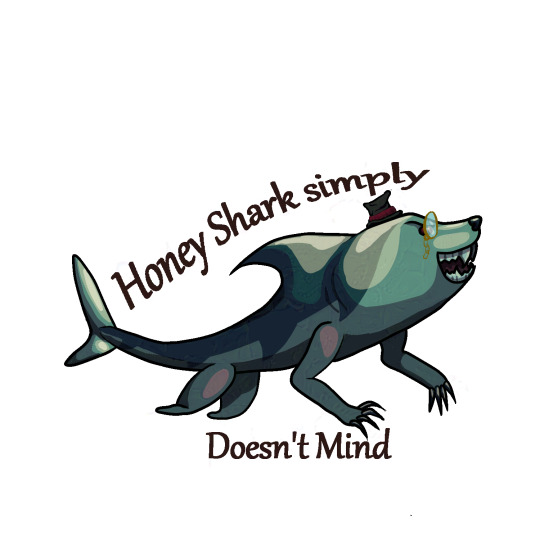
Honey Shark Doesn't Mind
Another one of those failed card game creatures, spruced up with a meme in hopes of selling red bubble designs.
Posted using PostyBirb
#my art#artists on tumblr#artwork#drawing#art tag#cbarts#digital art#art#furry artist#anthro artist#meme#meme art#shark#badger#honey badger#sharky#honey badger dont care#animal hybrid#original species#funny art#shark meme#badger meme
16 notes
·
View notes
Text
SHARKANS ARE NOW AN OPEN SPECIES!!!!!! PLEASE FOLLOW SPECIES RULES!!!!


PLEASE FILL OUT THE FORM IN REBLOGS OR COMMENTS TO MAKE ONE!!!!!!
(The form is temporary, I just want it here for the beginning ^^)
Sharkan name:
Traits:
Is a trait you want a rare? Please name it:
A short bio of you Sharkan:
Here's an example of a Sharkan!

35 notes
·
View notes
Text

(Please click for quality it looks so crusty)
🎶 Teenage mutant ninja SHARKIES 🎶
Heroes with the fish tails, sharky power!
MASTERPOST
(Individuals pics and yapping under the cut ^^)
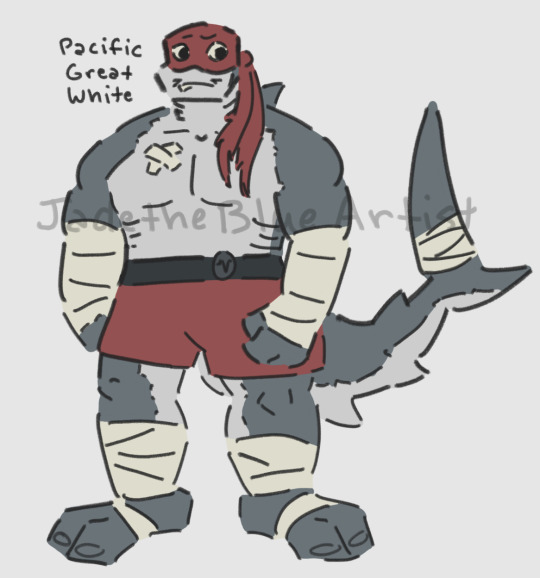

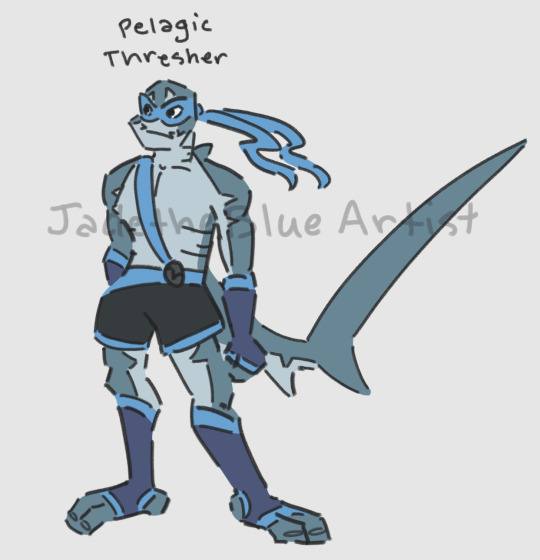
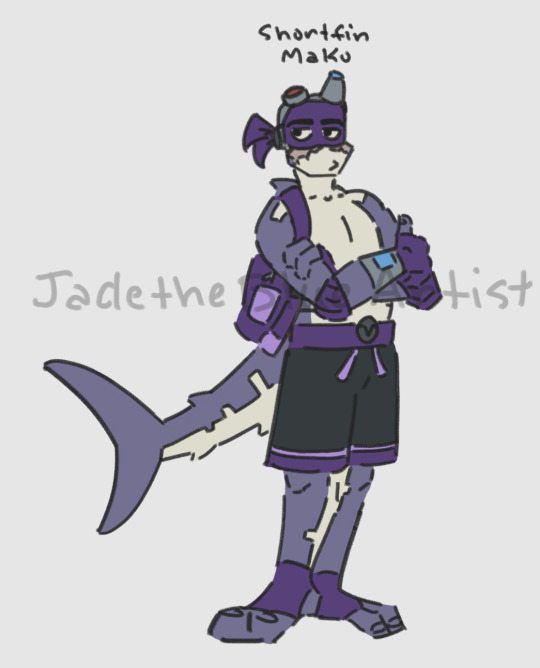
HEHE THE HYPERFIXATION CONTINUES this took my several hours bc i draw so slowly and dont realize it so that was great but i really like them ^^
Raph is a great white just bc I thought it fit, Mike is a leopard shark bc of spots and bc little, Leo is a pelagic thresher bc he’s a speedy boy, and Donnie is a shortfin mako bc they’re very smart!
I was trying to find an equivalent to sharks for Donnie and his soft shell but i couldn’t think of a species specific thing so I’ve decided that when they were rescued my Lou, he got burn damage to his snout where his sensing organs are and since sharks rely on that organ a lot due to they’re poor eyesight, he can struggle in seeing things. Technically they all have awful eyesight but the others can sense the electro magnetic fields and whatever so they’re good. Hence Don needs glasses and just still struggles beyond that.
Ummmmm yeah so they all have tails and dorsal fins and little fins on their tails. They each have sets of gills on their necks and rib area while also having lungs. They can breathe underwater then, they just have to keep their mouths closed. I also think their lair situation would be the same with more pools for them since they do like water but their human characteristics don’t make them dependent. Maybe just water lovers and avid moisturizers.
OKAY IF ANYONE WANTS TO SEND ME AN ASK ABOUT THIS ID BE HAPPY TO TALK BUT YOU KNOW UP TO YOU TEEHEEHEEHEE I NEED TO EAT NOW BYEEEEEEE
#rottmnt#rise of the teenage mutant ninja turtles#rise of the tmnt#tmnt#save rottmnt#riseofthetmnt#save rise of the teenage mutant ninja turtles#save rise of the turtles#rottmnt raph#rise raph#rottmnt mikey#rise mikey#rottmnt leo#rise leo#rottmnt donnie#rise donnie#teenage mutant ninja sharkies#rottmnt au#rise au#sharks#rottmnt sharks#great white shark#leopard shark#pelagic thresher#thresher shark#shortfin mako shark#jadethebluearts#teehee now I wanna do the rest of the family#tho idk how different they’d be…. the possibilities
837 notes
·
View notes
Text
Behold the Killiescape
@elodieunderglass
I swear I saw a post recently (this morning?) about Killieposts being tricky to navigate, but now I can't find it to reblog. Anyway.
JANUARY & PRIOR
Preprequel posts
Charlie's from bawstin
Prequel posts (Apollonic wafts of the jockeyposting to come)
Those are his Hooves, you Bitch
Willie Shoemaker the man that you are
Jockeyposting
Killie posts:
The benefits of a Jockey OC
Killie and Derek
Tags of jockeyposting
Killie/jockey infodump
Why are jockeys not supposed to look at smartphones?? will it make them heavier
Common jockey injuries
Concussions are not good
60 jockeys paralysed a year (jesus fucking christ)
your unreliable narrator bit me [Is this a Killie post? No, but you know what? Yes.]
Dick Francis books
And it WORKED! (first instance of greyuncle posting?)
FEBRUARY
Greyuncle dog collection
Jockeyposting (non-Killie)
Bear boyfriends and tiny jockeys
More Dick Francis/Killie does not solve crimes
What's Killie short for? or, my favorite killie comic of all (huntin badgers. hah.)
is this, too, a sort of killieposting? (it is to me)
Killie's family
Horseboy daemons
what's Killie's guilty pleasure OMELETTE WITH YOLK IN Y'ALL
is it pronounced silly? it's pronounced silly-ian wait killie what are you doi- 😵💀🪦
what's the stupidest thing killie ever did on a horse? (eyyy that's me 😎) (this response began my infatuation with Colm)
When and why does Killie retire?
How'd Killie and Derek meet?
one must imagine killie suffering in a dressage event
extremely normal relationship
killer instinct
breeds of jockey
killie's accent
oh holy horrible thing with legs/meat identification
liver chestnut liver chestnut liver liver liver chestnut (look i think i'm funny and i'm the one tracking down the links so you all just have to suffer me. okay.)
killyjamas
breeds of jockey reblog: conflict of interest
killie IS better than his dad
how tall IS Derek (https://elodieunderglass.tumblr.com/post/775827017476227072/i-have-to-know-how-tall-is-derek-is-he-actually) (hah killie is an inch shorter than my nana) (he smol)
more about charlie/snail racing
jockey representation
EXTREMELY normal relationship
racehorse blinders (i'm making the list. i decide what counts. im the captain now.)
what are jockeys for
here/gone/here (i'm not crying! 😭 YOU'RE crying!)
magical twin telepathy (that doesn't exist)
special jockey powers (balance)
CRIMES! CRIMES, KILLIE. Species Swap AU
trotting: real gait or not?
killie bundled up
A Bad Egg: Killie in Temeraire which gets it's own line to make it stand out because GO READ THIS!!!
a sewing machine is a kind of horse: killie on great british sewing bee
Derek's family
SHARKY watchadoin ✨🛎️✨
Killie the jockey OC and his coworkers
killie + textposts
killie book someday <3
has killie raced in the us/on dirt?
charlie knits
terms that are (probably) from horse racing
jockeyposting/nope (2022)
jc leyendecker
how jockeys live
did charlie know he wasn't going to be a horse pilot
killie? kili?
killie is a scrungly cat
tall colm
THE EGGS BEGIN EGGS FOR KILLIE! (with the yolk in!!)
-- february took twice as long as I thought (only partly because I got distracted reading the posts, I swear), so I'll do march tomorrow.
155 notes
·
View notes
Text
Wet Beast Wednesday: sawfish
It's the first Wet Beast Wednesday of 2025 (yeah I missed last week, sue me) and I'm going to cover a fish I once saw. That's right, I saw a fish. A sawfish if you will. These besnouted beasts were once common worldwide, but now their range had shrunk considerably, leaving their future in question.

(Image: a largetooth sawfish, Pristis pristis, seen from above. It is a flattened, shark-shaped fish with light brown skin. From the front of the body extends a long, slat snout with teeth emerging from the sides. The snout is about a third the length of the body. The mouth and gills are not visible. End ID)
Sawfish are also called carpenter sharks, but they aren't sharks. Despite looking sharky enough, they're actually rays and are closely related to other not very ray-like rays like guitarfish and banjo rays. I don't know why they're so musical. Sawfish should also not be mistaken for the visually similar sawsharks of order Pristiophoriformes, which actually are sharks. There are five living species of sawfish in the family Pristidae: four species in the genus Pristis and one in the genus Anoxypristus. Sawfish look like sharks with flattened underbellies, but their mouths and gill slits being on the underside identified them as rays. The sawfish and their relatives may represent an ancestral form to most modern rays which are much flatter and more compact. What gives sawfish their names are the long, flat, and broad rostrums that extend from the front of their heads and are lined with teeth on either side, giving them a resemblance to carpentry saws. Sawfish are very large fish, with some being able to up to 7.5 meters (25 ft) long and 600 kg (1,323 lbs).

(Image: a smalltooth sawfish, Pristis pectinata, seen from the side. It looks very similar to the largetooth sawfish, but with smaller teeth on the saw. The flatness of the belly is clearly visible form this angle. The underside is white.)
The saw is an extension of the skull and the teeth that line the sides are heavily modified dermal denticles, the teeth like scales that sharks, skates, and rays have. The saws and teeth grow longer through the animal's life and lost teeth are not replaced, but do leave a socket, allowing an accurate count to be made. The saws are not perfectly symmetrical and one side will usually have 1-3 more teeth than the other. The two genera of the sawfish can be differentiated by their rostral teeth. The Pristis species have saws that have rounded teeth going down the entire length while Anoxypristis cuspidata, the narrow sawfish, has flattened teeth and the 1/4th of the saw closest to the head is toothless. A sawfish's saw usually makes up 1/4 to 1/3rd of their total length. Each species has slight differences with the structure of their saws, allowing for identification. The saw and head are covered in electroreceptive organs called ampullae of Lorenzini that detect the electrical fields emitted by animals as they move. This grants the sawfish extensive ability to examine their environments through their saws, which is highly useful for hunting and threat detection, especially in water with low visibility.

(image: somebody holding a juvenile sawfish so the saw pokes out of the water. The saw is the focus of the picture, making its shape and the rostral teeth clearly visible. End ID)
Unlike your average ray, sawfish have multiple distinct fins much more like a shark, lacking only the anal fin. Again, the ancestral ray was probably something like a sawfish or guitarfish. Some of its descendants would have retained its body plan while other became typical rays. Like other elasmobranchs, sawfish (except for the narrow sawfish) have dermal denticles for scales and lack a swim bladder, instead using a very fatty liver for buoyancy control. Like most rays, they do not use their mouths for respiration, instead drawing water into the oral cavity through spiracles located near the base of the saw. These spiracles allow the animal to continue to pass water through the gills even when the mouth is flat to the ground. The nostrils, gill slits, and mouth are located on the underside as well. The mouth has proper teeth, which are blunted and set in multiple rows that have been described at looking like a cobblestone road. These blunt teeth aid in crushing the shells of hard prey. As with many other elasmobranchs, the small intestine has a corkscrew-shaped structure called the spiral valve that increases the surface area, allowing for increased nutrient absorption.

(Image: a sawfishs head seen from below. The mouth is wide and roughly rectangular in shape, with rows of pebble-like teeth visible. Above the mouth are a pair of nostrils. End ID)
Sawfish were historically found in shallow, coastal waters in subtropical and tropical water worldwide, but their native range has been radically reduced. While primarily marine, they can tolerate brackish and even fresh water. The largetooth sawfish, Pristis pristis, is especially attuned to fresh water. They live in rivers and lakes for the first several years of their lives and have been found thousands of kilometers inland. Despite sailor's tales of sawfish cutting open the bellies of whales to feed on their entrails, the fish actually feed on small fish and invertebrates. The saw is used for both finding and obtaining food. By using smell and the electroreceptors covering the saw, the sawfish can seek out animals on or buried in the sediment. It uses the saw to strike prey animals, stunning or killing them. They are also known to pin prey down with the saw, something they also do to maneuver food into a more swallowable position. Sawfish may also use their saws to dig buried prey out by sweeping away layers of sediment. They prefer to live in places with soft sediment, though will also inhabit coral reefs.

(Image: a narrow sawfish, Anoxypristis cuspidata, being beasured. It looks like the other species, but its dorsal and tail fins are a much darker brown than the rest of its skin. The saw only has teeth on the last 2/3rds and the teeth are flatter and more triangular. End ID)
Like other elasmobranchs, sawfish reproduce internally. Males are believed to use their electroreceptors to locate mature females. The male bites onto the female's pectoral fin and inserts one of two penis-like claspers into her cloaca. Sperm runs down a groove in the clasper. Females are often left with scars from the male's teeth and saw. The smalltooth sawfish, Pristis pectinata, is capable of parthenogenesis, producing offspring without a mate, and other species may also be capable of doing this. This allows females to reproduce even if they cannot access a male, but means all offspring will be female and genetically extremely similar to the mother. Sawfish are ovoviviparous, meaning they retain their eggs, which hatch internally, and give live birth. The fetal offspring are nourished with a yolk sac before being born. The saw is soft in fetu, hardening shortly before birth, and is covered with a coating to protect the mother which falls off after birth. Gestation takes months Juveniles are born in litters numbering between 1 and 20. Newborns can be up to a meter long. Females appear to mate between once a year and once every two years and mothers will sometimes return to their place of birth to give birth. Pupping grounds are always in shallow coastal or estuarine waters. Sawfish mature slowly. The narrow sawfish reaches sevual maturity after 4.5 years and the Pristis sawfish between 14 and 17 years. Their maximum lifespan is unknown, but Pristis individuals in captivity have lived for decades, leading to an estimated lifespan of 30 to 50 years. The narrow sawfish lives for around 9 years.

(Image: a photo from the first human-assisted birth of a wild sawfish. The mother is on her back and a juvenile sawfish is almost completely emerged from her cloaca, with only the tail fin still inside. The hand of a scientist is touching the baby, helping it emerge. End ID. Source)

(image: a newborn sawfish being held in a human hand underwater, from the same incident as the above photo. The newborn looks like a miniature adult and has a soft covering over its saw that makes the teeth harder to see. It is small enough to be partially clenched in a hand. End ID)
All species of sawfish are classified as critically endangered by the IUCN and they are considered some of the most threatened groups of fish. While sawfish were formerly found along the coasts of 90 countries, their nange has reduced considerably so the only strongholds where they are abundant and have a genetically viable population are now found in northern Australia and Florida. The main threats to sawfish are hunting and habitat loss. Sawfish are hunted for their fins, saws, and meat. Despite not being sharks, their fins are highly values for shark fin soup. Sawfish body parts are used in traditional medicine in multiple cultures, though the greatest demand comes from China. There is no evidence backing up the effectiveness of any of these traditional medicines. The saws have historically been used as weapons, combs, and for various symbolic purposes and poaching of sawfish for their saws is another major threat to their survival. The saws are easily tangled in nets, making sawfish easy to catch and difficult to release. Because a thrashing sawfish can seriously wound someone, many anglers will either kill the fish or cut off the saw if they accidentally catch one. Habitat loss is another large threat, as pollution and destruction of seagrass beds and mangroves for urban developments deprives them of the habitat they need to hunt and breed. Because sawfish mature so slowly, it takes a long time foe populations to recover. Legal measures (including making international trade of sawfish parts illegal) and public outreach via scientists and aquariums aim to help protect the remaining populations. Unfortunately, captive breeding has proven unreliable as it is only recently that sawfish have been successfully bred in aquariums.

(Image: a decorative sword made from a sawfish saw. The saw is dried and a deep brown. It is attached to a curving crossguard and a long hilt with fluffy decorations. It is being stored in a museum display. End ID)
#wet beast wednesday#sawfish#rays#stingray#elasmobranch#cartilaginous fish#endangered species#fish#fishblr#fishposting#marine biology#biology#ecology#zoology#animal facts#informative#educational#image described
124 notes
·
View notes
Note
Out of curiosity: If you were to evolve Coro and Taima, what would you call their new species' name?
They were an Oshachu, then now they're Dewchu. The best Samurott/Raichu combination I can think of would be Samuraichu (with "rai" in raichu conveniently completing the word "samurai" lol). 🙃
Also, I imagine Coro wanting to become part Kantonian Raichu part Hisuian Samurott (higher Attack) and Taima, part Alolan Raichu part Unovan Samurott (higher Special Attack).
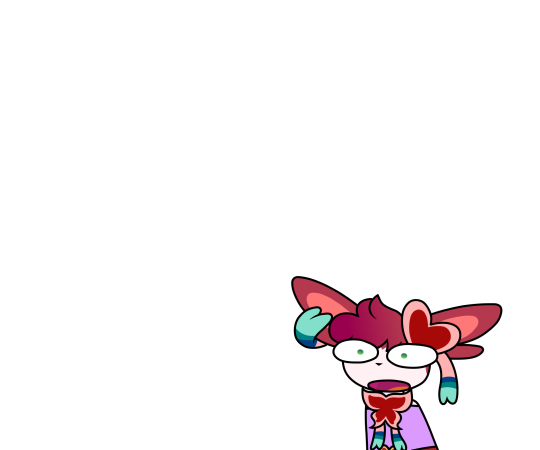
IT'S SO FUNNY THAT YOU SAY THAT ALL SPECIFICALLY
BECAUSE YOU'RE FUCKING RIGHT
MY STUPID RAMBLINGS DOWN BELOW, READ IF YOU WANT
So the ORIGINAL plan for Coro and Taima was for them not to evolve. This was mostly because me and Sharkie (@occasional-wott-bros) looked at Samurott's helmet and went "Mmm... no thanks, actually." We did do up a couple of concepts for these evolutions though, and it was more of a "We're not actually doing this, so take these" kind of thing.
Then uh.... Then some backstage planning was happening between me and another friend, @ask-neontiger/Jordy.
This happened a couple of years ago, especially when I was heavily clingy to Future!AU, and I ended up making a design for Evolved Taima that I really loved! Coro was a real pain in my side though, so I put him on a shelf to deal with later.
Hisuian Samurott was revealed and I knew that was gonna be a part of Coro's evo, but I just couldn't for the fucking life of me get a design that I was happy with and it was pissing me off. Another friend of mine, @flaaffodills helped me out and gave me the perfect idea for Evolved Coro as well, and here they both are now!

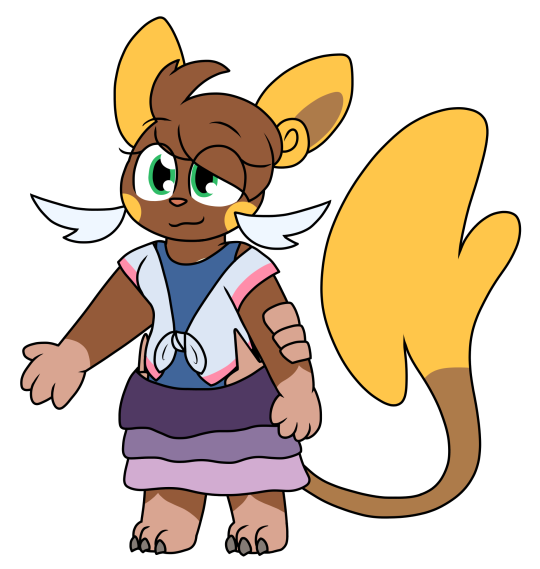
I'm INCREDIBLY happy with how both of them came out, and I will always give my thanks to Mac/Flaaffodills for helping me pull together a design for Coro that I was finally okay with.
#Talking to Valentine#ooc#I got scared for a moment like what the fuck ifudsbjs#how'd you hit the nail on the head so goddamn perfectly?#am i that predictable? damn
57 notes
·
View notes
Note
*grabby hands* give me sharkie facts
most sharks have two dorsal fins, but not all!! such as
order Hexanchiformes, with 6 species: frilled sharks (2), sixgill sharks (2), and sevengill sharks (2)
in order Carcharhiniformes: one fin catshark! Pentanchus profundicolus
#sharks#shark info#asks#hexanchiformes#frilled shark#six gill shark#sevengill shark#one fin catshark#catshark
51 notes
·
View notes
Text


I don't have the brainpower to come up with names but uuuuuh here's some alien concepts
- at first I was only going to make the more humanoid/bipedal aliens keep the tie, but then I decided screw it. For the goof.
- I like the idea of George's aliens incorporating elements like his red color motif, or some kind of stripe pattern similar to his tie. I'm not entirely satisfied with how it looks on sharky up there but you get the gist.
- (did the shark alien species ever get a name?? I do not remember)
- also. I may be skewing canon a little bit here, but I'm going with the idea of the shark aliens being general shapeshifters, with an emphasis on creating duplicates of existing people and creatures. Right now George mostly uses this to disguise himself as various animals because duplicating human people is a bit more complicated and he does not have the patience.
- Shark is good for stealth and speed, while Biglien would be more like the tank of George's team
- Harold is here for moral support :)
79 notes
·
View notes
Note
may i request a pack of 5 alters?
human in species but themed after animals any transid is fine with me
could i get alters based off of these animals: shark gecko lionfish seal orca/killer whale
i'm so sorry this took soo long. lots of chronic pain issues and i have surgery tmr xd. anyway here you go!
ALTER PACK OF 5
requested by anon
୨୧ ─ name : sharky , kiera , mako
୨୧ ─ age : 14-17
୨୧ ─ pronouns : she / they
^ neopronoun ideas : fin / sharp / bite / fang / splash / prey
୨୧ ─ gender : nonbinary , tfem
^ xenogender ideas : sharkgender , sharkcomfic , genderaqua
୨୧ ─ sexuality : pomosexual , sapphic
୨୧ ─ species : human
୨୧ ─ roles : soother , symptom holder , gatekeeper
୨୧ ─ source : brainmade
୨୧ ─ transids : transshark , transsharpteeth , raceless , translegless
୨୧ ─ faceclaim :

୨୧ ─ name : koko , spyro , kaiju
୨୧ ─ age : ageless
୨୧ ─ pronouns : he / him
^ neopronoun ideas : cae / rawr / rept / doe
୨୧ ─ gender : transman
୨୧ ─ sexuality : androsexual
୨୧ ─ species : human
୨୧ ─ roles : janusian , mood booster
୨୧ ─ source : brainmade
୨୧ ─ transids : transhappy , transagere , permasleepy , caneian
୨୧ ─ faceclaim :

୨୧ ─ name : lion , kai , عادل (adel) , আরিফ (arif)
୨୧ ─ age : agehazy
୨୧ ─ pronouns : he / it / dull
୨୧ ─ gender : bxyflux
୨୧ ─ sexuality : biromantic , omnisexual
୨୧ ─ species : human
୨୧ ─ roles : intrusive thoughts holder
୨୧ ─ source : brainmade
୨୧ ─ transids : transmelanin , nulldepressed , transhpd
୨୧ ─ faceclaim :

୨୧ ─ name : laurie , camila , darling
୨୧ ─ age : 17
୨୧ ─ pronouns : she / they / mrrp
୨୧ ─ gender : girlflux, transfemneu
୨୧ ─ sexuality : sapphic
୨୧ ─ species : human
୨୧ ─ roles : caregiver
୨୧ ─ source : brainmade
୨୧ ─ transids : aracial , permasick , transprofession (swimmer)
୨୧ ─ faceclaim :

୨୧ ─ name : amara , laya , mik
୨୧ ─ age : 19
୨୧ ─ pronouns : he / she
୨୧ ─ gender : demigirl , tmasc
୨୧ ─ sexuality : pansexual
୨୧ ─ species : human
୨୧ ─ roles : physical protector , socializer
୨୧ ─ source : brainmade
୨୧ ─ transids : n/a
୨୧ ─ faceclaim :

33 notes
·
View notes
Text

Strawberry milkshake 🩷🍓
118 notes
·
View notes
Note
17 year old sorbet shark cookie alter?
One 17 y/o Sorbet Shark fresh out of the oven! Feel free to change or scrap anything that doesn't fit!
Headmate below cut!

༄~𖦹︎ Name(/s) ➪ Sorbet Shark, Sharky/Sharkie, Pup, Scout, Reef
༄~𖦹︎ Pronouns ➪ They/them, It/its, Shark/sharks, Fin/fins, Ocean/oceans, Sea/seas, River/rivers, Bite/bites, Crunch/crunchs, Jaw/jaws, Fish/fishs, Teeth/teeths, Tooth/tooths, Leather/leathers, Scale/scales, Cold/colds, Ice/ices, Sweet/sweets
༄~𖦹︎ Gender ➪ Sharkgender! [Shark gender collector/hoarder; all shark related genders], Sorbetic, Sorbetsharkic, Sorbetsharkcookiegender, Lemonsorbetgender, Mangberryicic, Snowconegender
༄~𖦹︎ Orientations ➪ Unlabelled
༄~𖦹︎ Age ➪ 17!
༄~𖦹︎ Species ➪ Cookie(?); Shark or shark hybrid
༄~𖦹︎ Role(/s) ➪ Avenger and/or Anger holder and/or Coltenoir and/or Brother Figure and/or Substitute and/or Stim Holder
༄~𖦹︎ Source or Theme ➪ Sorbet Shark Cookie
༄~𖦹︎ Appearance or Faceclaim ➪

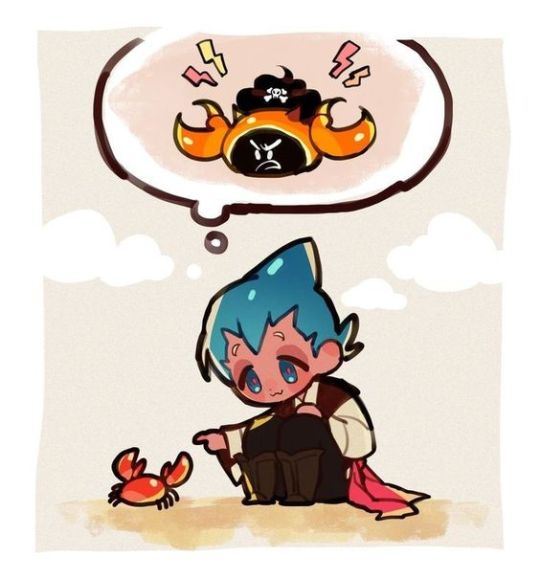
➪ Art Creds; 1 & 2
༄~𖦹︎ Likes ➪ Sorbet, gelato, shaved ice, snow cones, soft ice, milk ice, slushies, iced sweet tea, the beach, boats, marine / aquatic / semi-aquatic life, stars (it LOVES stars, this definitely stemmed from the liking shiny things, but eventually extended to star shapes), bioluminescence, glowing things, shiny things, soup (fin can't taste the vegetables in it), meat (especially fish & bird meats), loud areas, people who are happy to just ramble or infodump to fin (it means sea doesn't have to speak as much), swimming
༄~𖦹︎ Mixed Feelings ➪ The depths, heights, night-time (likes getting to see the stars, dislikes the dark), cats (fin thinks they're cute but doesn't like how angry they are)
༄~𖦹︎ Dislikes ➪ Scary things, most vegetables, being alone, the quiet, poachers
༄~𖦹︎ Proxy Option ➪ 🍧🦈/🍨🌊/🍧🏴☠️
༄~𖦹︎ Personality Traits/Quirks ➪ "Oooo00ooOoo" vocal stim, has a habit of folding paper stars, semi-verbal & hyper-vocal (vocal as in noises, verbal as in actual words/attempted words) and prefers not to speak, may use AAC apps but definitely prefers the ones where you can draw what you want to say, will draw stars if it gets hold of a pen (on paper, in books, on your arms/legs/hands, if there's a pen, shark will draw stars on the body (and those fin considers a friend))
༄~𖦹︎ Moodboard ➪

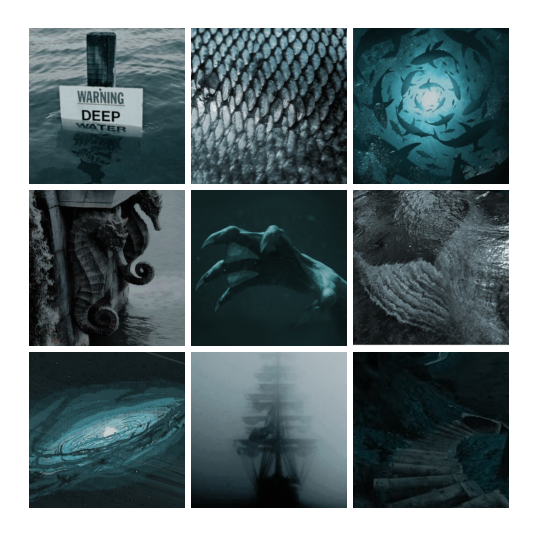
➪ Moodboard Creds; Both put together by us
༄~𖦹︎ Aesthetics ➪ Selkiecore, Sirencore, Piratecore, Dark Nautical
༄~𖦹︎ Fears ➪ The dark, the unknown, big birds
༄~𖦹︎ Front Triggers ➪ Paper star paper, nights where there are no clouds or smogs so you can see all of the stars, the beach, swimming
༄~𖦹︎ Typing Quirk(/s) ➪ Occasionally interchanges O and 0
➪ Random Sentence Example; "Ooo0oO0oo0" // "OooOoOOooO"

COOKIE /positiveconnotations also Fun fact: shark skin feels like leather despite their scales! How do I know? I got to pet a shark once teehee (sharks are based) -Bee
#duckys bah#duckys requests#build a headmate#alter packs#build an alter#bah#alter creation#headmate creation#headmate pack#cookie run#sorbet shark cookie#alterpack
11 notes
·
View notes
Note
Can we request a level 3 Kirishima from MHA
Of course dear audience! We have heard your request and have found a suitable performer for you! We hope this performance suits your needs, but you are free to make any adjustments you wish.
❣︎For Our Next Act, Please Welcome,,,❣︎
Kirishima!!!

°·⊱ Name: Kirishima, EIjirou, Sharky, Red, Nero, Adrian, Reid / Reed
°·⊱ Age: 16
°·⊱ Race/Species: Human (Quirked)
°·⊱ Source: My Hero Academia
°·⊱ Role: Physical Protector, Emotional Support, Confidence Booster
────── · · · · ──────
°·⊱ Sex: Male
°·⊱ Gender: Sharkgender, Rockgender, Manlygender, Strengthgender
°·⊱ Pronouns: He/Him; Shark/Sharks; Bite/Bites; Rock/Rocks; Sharp/Sharps; Red/Reds; It/Its
°·⊱ Sexuality: Gay / Uranic
°·⊱ Personality: Extremely passionate about strength and manliness, just like his source. Encouraging to others, always ready to help build confidence. Loud and boisterous but genuinely caring.
────── · · · · ──────
°·⊱ Likes: Weight Training, Protein Shakes, Helping Others Become Stronger, Sharks, Rock Music, Manly Activities, Sparring, Wants to learn how to crochet (it's a secret)
°·⊱ Dislikes: Cowardice, Bullying, Feeling Helpless, Bitter Foods, Being Called Weak
°·⊱ Emoji Sign-Off: 👊🪨💥
°·⊱ Typing Quirk: Overuses punctuation, mainly exclamation points and question marks. (like this!!!!???!?!?!??!)
────── · · · · ──────
°·⊱ TransIDs: transShark, transVapeUser, transRedHair, transNicotineAddict, trisADHD, trisAutism, transAdored, nullBullied, transtransMale
°·⊱ CisIDs: Quirk User, Mixed (JP and Black), Red Eyes, Black Hair, ADHD, Autism, Hero in Training, Student
°·⊱ MUDS: Fantasychosis
°·⊱ Paras: 🐲, 🥚, 😖, 🦖, 💐, 🛐, ♂️
°·⊱ Faceclaim: 1 | 2



Thank you so much for the request !! May he settle in nicely !! - Pest Swarm ; Ten


#★Act Request★#bah#build a headmate#build an alter#alter pack#alter packs#alterpacks#radqueer#rq🌈🍓#rq safe#endogenic#pro endo#endo safe#willogenic#tulpamancy
6 notes
·
View notes
Note
SHARKIE QUESTIONS!!
Do they ever knock things over with their big ol tales?
Does April get to ride on them while they swim?
WOULD THE MUD DOGS BE TURTLES INSTEAD?
Are they mainly carnivorous?
Does Donnie ever just… run into walls? Like when he isn’t wearing glasses or contacts? (Idk it seems funny in my mind)
Okay that’s all for now :D
SHARKIE ANSWERS!
-Yep hahaha especially Leo bc his is so long. They don’t hit stuff in the lair too often unless people move things around bc those are some well adjusted sharkies, but on missions (think some closer areas like maybe Big Mamas hotel) they be knocking things down
-Yes of course ^^ Big sis gets her privileges
-Ok ok ok so I’m trying to use a sort of system for changing the species to keep things consistent (bc I really like that) and it’s more or less switching them from whatever animal category they are (mammal, reptile, bird, etc) to one more watery. So I’ll have to think of the mud dogs designs for specifically later but as an idea, Danny is a rat type thing I think so I’d change him to some sort of amphibian or reptile (potentially a turtle bc I DO want at least one turtle), and then Leonard- what is Leonard? Lemme look it up….. an ogre? Ok well apparently he’s an ogre so like maybe he’d be a mer ogre or something hahah idk the system is flexible, I do know tho that since Mickey is an eel he would be the end of the system and get changed into a mammal so yeah fun stuff
-Yep! Since all of their sharkness is struck carnivorous, they’re mainly carnivores. Other stuff still is good for them since they are part human but about 50% of their diet is meat. They might survive on less they would just see the consequences of less nutrition
-Oh even when he is wearing glasses or contacts that boy is just hitting walls. (Idk if it’s sharkly factual but just go with me ig hahaha) so they can’t see fine details or many colors naturally so there isn’t much Don can do to fix that with glasses so his detail perception is improved but the color blindness isn’t. That with his eyes not working great in the first place and his electromagnetic sensors being messed up, he’s struggling, that’s why most of his tech assists in that sort of thing: sensing his surroundings, navigating him, etc etc
(Oh and here’s a little scale of most to least visually impaired [this goes for both being able to see details and color, not electromagnetic sensing since everyone but Donnie is great on that]: Donnie, Raph, Leo, Mikey)
Oh and then also this makes their color coordination funny bc Donnie swears his favorite color is purple and only purple and he can tell but one time Leo replaced his things with blue and Don didn’t notice and was so mad when he found out
OKAY THESE WERE SO FUN THANK YOUUUUUUU
MASTERPOST
#shorks#teenage mutant ninja sharkies#sharks#rottmnt#rise of the teenage mutant ninja turtles#rise of the tmnt#tmnt#save rottmnt#riseofthetmnt#save rise of the teenage mutant ninja turtles#save rise of the turtles#rottmnt raph#rottmnt mikey#rottmnt leo#rottmnt donnie#rottmnt april#rottmnt mud dogs#rottmnt au#rise au#jadethebluerambles#ask#moo
22 notes
·
View notes
Text
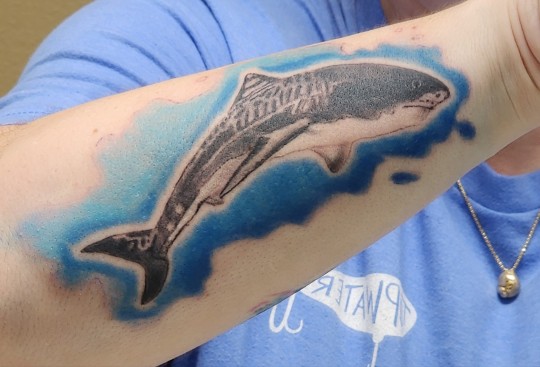
Hey my sharky friends! I wanted to show y'all my newest tattoo!! Tiger sharks are favorite species of shark, and I've been dying to get a tattoo of one for the longest time! Today I finally made it a reality! I'm so in love with it! ❤️🦈
#tiger shark#favorite shark#shark tattoo#new tattoo#tatted shark girl#just a girl who loves sharks#i love sharks#shark blog#shark post#tattoos#tattoed girls#tatted#tatted up#marine life tatttoo#it's so pretty
57 notes
·
View notes
Text

my dear riptide oc has been redesigned look at him in his full sharky glory
gravel lore below (some taken from my old ref)
He is an artificer/druid cryptozoologist! Technically he is Sharkfolk based on a winghead shark but mechanically he is more like a Triton with an extra bite attack (because I haven't found a homebrew sharkfolk that I like)
He goes around researching and documenting cryptids!! He writes it all in his diary (the leather book, it's magical as well), makes artists impressions of cryptids according to the information he's collected and would probably be part of a cryptozoologist enthusiast club.
He also occassionally publishes his findings to like a small subscription magazine!! cryptid facts, sightings, stories etc.
Aside from cryptids, he also has done research on the species within Mana (e.g. documentation and studies) but his main interest is still cryptids.
He is very independent!! He has no crew and is usually solo so he usually hitchhikes on other pirate ships to get around and helps them out in exchange.
His damaged dorsal fin is actually from a run in with a navy battleship while he was on a pirate ship that did not turn out very well. Since he is pretty close with a lot of pirates he is indirectly also an enemy of the Navy government (he hates the navy anyway so its fine). I would consider him a true neutral.
He makes most of his artificer stuff out of bone because of the druid metal thing: he just paints it to appear metallic because he likes how it looks :]
fun facts:
- if you could not tell from the earring on the right: yes he is also gay
- he has 360 vision (like most hammerheads) and very good spatial awareness!
- his artificer subclass is alchemist but I still haven't decided the druid subclass. I am likely leaning towards circle of the stars or moon due to his ties to the water.
42 notes
·
View notes